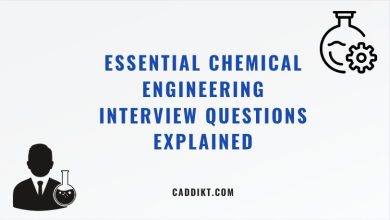Preparing for a mechanical engineering interview can be both exciting and nerve-wracking. As a mechanical engineer, it is essential to have a solid understanding of the key concepts and principles of the field. To help you in your interview preparation, we have compiled a list of 50 commonly asked mechanical engineering interview questions along with their answers. These questions cover a wide range of topics, including mechanics, thermodynamics, fluid mechanics, materials, and design principles.
By familiarizing yourself with these interview questions and practicing your responses, you can boost your confidence and improve your chances of success in your mechanical engineering interview. Remember, the interviewer is not just assessing your technical knowledge but also your problem-solving abilities, communication skills, and aptitude for teamwork.
In this article, we will provide clear and concise answers to each of the 50 mechanical engineering interview questions. We will cover the fundamental principles of mechanics, different types of forces, stress and strain, heat transfer, fluid mechanics, gears, torque, welding techniques, and much more. So, let’s dive in and equip ourselves with the knowledge and confidence needed to excel in a mechanical engineering interview!
Top 50 Basic, Advanced and expert level Mechanical Engineer Interview Questions
1. What is mechanical engineering?
Mechanical engineering is a discipline that involves the design, analysis, and manufacturing of mechanical systems. It encompasses various areas such as mechanics, thermodynamics, materials science, and kinematics to develop solutions for problems related to machinery, energy conversion, and mechanical systems.
2. What are the fundamental principles of mechanics?
The fundamental principles of mechanics include Newton’s laws of motion, which describe the relationship between the motion of an object and the forces acting upon it. These principles form the basis for understanding how objects move and interact with each other in mechanical systems.
3. What is the difference between statics and dynamics?
Statics deals with the equilibrium and balance of objects at rest or moving at a constant velocity, whereas dynamics involves the study of objects in motion and the forces causing that motion. In other words, statics focuses on systems in equilibrium, while dynamics examines the forces that cause acceleration or deceleration.
4. What are the different types of forces in mechanical engineering?
There are several types of forces in mechanical engineering, including compression, tension, shear, bending, torsion, and friction. Each type of force has its own characteristics and effects on mechanical systems.
5. What is stress and strain?
Stress is the force per unit area applied to a material, while strain is the deformation that occurs in response to the applied stress. Stress and strain are important concepts in understanding the behavior of materials under mechanical loads.
6. How does material selection affect mechanical design?
Material selection plays a crucial role in mechanical design as different materials have distinct properties that can affect factors such as strength, durability, weight, and cost. Engineers must consider these properties and select materials that best suit the requirements of the design.
7. What are the different types of bearings and their applications?
There are various types of bearings used in mechanical systems, including ball bearings, roller bearings, plain bearings, and fluid bearings. These bearings enable smooth rotation or linear movement and find applications in machines, vehicles, and industrial equipment.
8. What is the purpose of a cam and follower mechanism?
A cam and follower mechanism is used to convert rotational motion into reciprocating or oscillating motion. It consists of a cam, which is a specially shaped rotating element, and a follower that tracks the cam’s shape and translates the motion. This mechanism finds applications in engines, printing machines, and other devices requiring precise control of motion.
9. How does heat transfer occur in mechanical systems?
Heat transfer occurs through three main mechanisms: conduction, convection, and radiation. Conduction involves the transfer of heat through direct contact between materials, convection involves heat transfer through the movement of fluid, and radiation refers to the emission of electromagnetic waves carrying thermal energy.
10. What is the difference between conduction, convection, and radiation?
Conduction is the transfer of heat through direct contact between materials, while convection is the transfer of heat through the movement of fluid. Radiation, on the other hand, is the transfer of heat through electromagnetic waves without the need for a medium. These three mechanisms play distinct roles in heat transfer.
11. How does fluid mechanics relate to mechanical engineering?
Fluid mechanics is a branch of physics that studies the behavior of fluids, both in motion and at rest. It is closely related to mechanical engineering as many mechanical systems involve the use of fluids, such as pumps, turbines, and hydraulic systems. Understanding fluid mechanics helps engineers analyze and design efficient fluid flow systems, optimize energy transfer, and predict the performance of mechanical components and systems.
12. What is the Bernoulli principle?
The Bernoulli principle states that as the speed of a fluid increases, its pressure decreases, and vice versa, assuming no energy is added or lost. This principle is based on the conservation of energy in fluid flow and is used to explain phenomena such as lift in aviation, the operation of carburetors, and the functioning of wind tunnels.
13. How does an internal combustion engine work?
An internal combustion engine is a type of heat engine that converts the chemical energy of fuel into mechanical energy through combustion. It operates by igniting a mixture of fuel and air inside a combustion chamber, which causes rapid expansion of gases. This expansion creates high pressure, driving a piston, which in turn generates rotational motion, providing power to propel vehicles or drive machinery.
14. What are the different types of gears and their applications?
There are various types of gears used in mechanical systems, including spur gears, helical gears, bevel gears, worm gears, and rack and pinion gears. Each type has specific advantages and applications. Gears are commonly used to transmit motion and power between rotating shafts, providing speed reduction, torque multiplication, or direction changes in machines and mechanical systems.
15. What is the concept of torque in mechanical systems?
Torque is a measure of the rotational force applied to an object around an axis. It determines the object’s tendency to rotate and is calculated as the product of the applied force and the distance from the axis of rotation. Torque plays a crucial role in various mechanical systems, such as engines, motors, and rotating machinery, as it affects the acceleration, deceleration, and overall performance of these systems.
16. How do you calculate the power output of a machine?
The power output of a machine can be calculated using the formula: Power = Work / Time. Power is a measure of the rate at which work is done or energy is transferred. It quantifies the machine’s ability to perform tasks or generate energy within a given time frame. The unit of power is typically expressed in watts (W) or horsepower (hp).
17. What is the difference between stress and strain?
Stress is the force per unit area applied to a material, while strain is the resulting deformation or change in shape of the material. Stress measures the internal forces within a material, while strain quantifies the material’s response to those forces. Stress and strain are related through material properties, such as Young’s modulus, and play a significant role in the design and analysis of mechanical systems.
18. What is the purpose of a flywheel in a mechanical system?
A flywheel is a rotating mechanical device used to store kinetic energy and provide smooth and consistent rotational motion. It helps to stabilize the rotation of a system by storing energy during periods of excess power and releasing it during periods of power deficiency. Flywheels are commonly used in engines, vehicles, and industrial machinery to maintain a steady output and absorb fluctuations in power.
19. How does the efficiency of a machine relate to its design?
The efficiency of a machine is a measure of how effectively it converts input energy into useful output energy. It relates to the design of the machine because factors such as friction, heat losses, and mechanical losses can affect the overall efficiency. A well-designed machine aims to minimize energy losses, optimize component performance, and maximize the conversion of input energy into the desired output.
20. What are the different types of welding techniques?
There are several welding techniques used in mechanical engineering, including arc welding, gas welding, resistance welding, laser welding, and electron beam welding. Each technique utilizes different heat sources and methods to join metal components together. Welding is commonly used in construction, fabrication, and manufacturing processes to create strong and permanent connections between materials.
21. What is the concept of thermal expansion?
Thermal expansion is the tendency of materials to expand or contract in response to changes in temperature. When a material is heated, its particles gain energy and move more vigorously, causing the material to expand. Conversely, when a material is cooled, its particles lose energy and move less, resulting in contraction. Understanding thermal expansion is crucial in the design of structures, pipelines, and other systems where dimensional changes due to temperature variations need to be considered.
22. How do you determine the safety factor in mechanical design?
The safety factor in mechanical design is determined by considering the maximum expected loads and stresses that a component or structure will experience during operation. It involves calculating the ratio of the maximum load the component can withstand without failure to the actual applied load. The safety factor ensures that the design has a sufficient margin of safety to account for uncertainties, variations, and potential failures, providing a level of reliability and preventing catastrophic failures.
23. What is the difference between fatigue and creep in materials?
Fatigue and creep are both failure mechanisms in materials, but they occur under different conditions. Fatigue refers to the weakening and eventual failure of a material subjected to cyclic loading or stress fluctuations over time. Creep, on the other hand, is the gradual deformation and failure of a material under constant load or sustained high temperatures. Fatigue is often associated with mechanical components, while creep is more relevant to high-temperature applications.
24. How does vibration analysis help in mechanical design?
Vibration analysis helps in mechanical design by studying the behavior and characteristics of vibrations in mechanical systems. It involves measuring, analyzing, and mitigating vibrations to ensure the optimal performance, reliability, and durability of structures and machines. Vibration analysis helps identify resonant frequencies, damping requirements, and potential vibration-induced failures, allowing engineers to design and optimize systems that operate smoothly and without excessive vibrations.
25. What are the different types of pumps and their applications?
There are various types of pumps used in mechanical systems, including centrifugal pumps, reciprocating pumps, diaphragm pumps, and gear pumps. Pumps are used to transport fluids by creating pressure and inducing flow. They find applications in industries such as water supply, oil and gas, chemical processing, and HVAC systems, to name a few.
26. How does fluid viscosity affect flow rate in pipes?
Fluid viscosity, which is a measure of a fluid’s resistance to flow, affects the flow rate in pipes. Higher viscosity fluids flow more slowly compared to fluids with lower viscosity. The flow rate is inversely proportional to fluid viscosity, meaning that as viscosity increases, the flow rate decreases. This is because viscous fluids experience more internal friction as they flow through the pipe, resulting in a reduced velocity and flow rate.
27. What is the purpose of a heat exchanger in a mechanical system?
A heat exchanger is a device used to transfer heat from one fluid to another, without them mixing, in order to control temperatures or recover heat energy. Heat exchangers find applications in various mechanical systems, including HVAC systems, power plants, refrigeration systems, and chemical processes. They enhance energy efficiency by facilitating the exchange of thermal energy between fluids, thereby maintaining desired temperature levels and conserving heat.
28. How does the second law of thermodynamics apply to mechanical systems?
The second law of thermodynamics states that in any spontaneous process, the total entropy of an isolated system always increases over time. It applies to mechanical systems by defining the direction of heat flow and the efficiency of energy conversions. The law sets limits on the efficiency of heat engines, highlights the irreversibility of processes, and emphasizes the tendency of systems towards increased disorder and entropy.
29. What are the different types of springs and their applications?
There are various types of springs used in mechanical systems, including coil springs, leaf springs, torsion springs, and gas springs. Springs are elastic objects that store mechanical energy and provide force when compressed, extended, or twisted. They find applications in numerous devices and systems, such as suspension systems, mechanical watches, automotive components, and industrial machinery.
30. How does material hardness affect mechanical properties?
Material hardness refers to the resistance of a material to indentation, scratching, or deformation. It is a key factor in determining the material’s mechanical properties. Harder materials generally exhibit higher strength, wear resistance, and durability. However, increased hardness may also result in reduced toughness or ductility. Material hardness affects the behavior of materials under various loading conditions, influencing factors such as component design, material selection, and surface treatments.
31. What is the difference between ductile and brittle materials?
Ductile materials can undergo significant plastic deformation before fracturing, while brittle materials fracture with little or no plastic deformation. Ductile materials exhibit higher toughness and are capable of withstanding higher tensile and impact loads. Brittle materials, on the other hand, have lower toughness and are prone to sudden, catastrophic failure. The distinction between ductile and brittle behavior is crucial in material selection and design to ensure the desired mechanical performance and failure resistance of components.
32. How does the concept of center of gravity apply to mechanical design?
The center of gravity is the point in a body or system where its weight is considered to be concentrated. It is an important concept in mechanical design as it affects stability, balance, and load distribution. The location of the center of gravity influences the behavior of structures, vehicles, and machines, helping engineers determine optimal designs, prevent tipping or overturning, and ensure safe and efficient operation.
33. What is the purpose of a governor in a rotating system?
A governor is a device used in rotating systems, such as engines or turbines, to regulate the speed or output. Its main purpose is to maintain a consistent and desired speed despite variations in the load or input conditions. The governor senses changes in speed and adjusts the input or output accordingly, either by controlling the fuel supply, adjusting the flow rate, or modifying the mechanical linkage. Governors are essential for stable and reliable operation of rotating systems.
34. How do you calculate the natural frequency of a mechanical system?
The natural frequency of a mechanical system can be calculated using the formula: f = 1 / (2π √(m/k)), where f represents the natural frequency, m is the mass of the system, and k is the stiffness or spring constant. The natural frequency indicates the inherent oscillation or vibration frequency at which the system tends to resonate. It is an important parameter in structural analysis, machinery design, and dynamic behavior prediction.
35. What is the role of lubrication in mechanical systems?
Lubrication plays a critical role in mechanical systems by reducing friction and wear between moving components. It involves the application of a lubricant, such as oil or grease, to create a thin film that separates and lubricates the contacting surfaces. Lubrication helps minimize energy losses, prevent excessive heat generation, extend component lifespan, and ensure smooth and efficient operation of machines and mechanical systems.
36. How does the concept of kinematics relate to mechanical engineering?
Kinematics is the study of motion, without considering the forces causing that motion. It relates to mechanical engineering as it provides a framework for analyzing and describing the movement of objects, mechanisms, and systems. Kinematics involves concepts such as position, velocity, acceleration, and trajectory, which are fundamental in understanding the behavior and performance of mechanical components, robots, vehicles, and other dynamic systems.
37. What are the different types of brakes and their applications?
There are various types of brakes used in mechanical systems, including disc brakes, drum brakes, regenerative brakes, and hydraulic brakes. Brakes are essential for controlling motion, stopping or decelerating moving objects, and ensuring safety. They find applications in automotive vehicles, industrial machinery, trains, and other systems where controlled stopping or speed regulation is required.
38. How does the concept of elasticity apply to mechanical design?
Elasticity is the property of a material that allows it to regain its original shape after deformation when the applied load is removed. It is a crucial concept in mechanical design as it determines how materials respond to external forces and loads. Elasticity influences factors such as flexibility, resilience, and stiffness of components, ensuring proper functionality and performance in various mechanical systems and structures.
39. What is the difference between closed-loop and open-loop control systems?
In a closed-loop control system, feedback is used to continuously monitor the system’s output and compare it to a desired setpoint. Corrections are made based on this feedback to maintain the desired output or performance. Open-loop control systems, on the other hand, do not utilize feedback and rely solely on pre-determined input signals. Closed-loop control systems offer greater accuracy, stability, and responsiveness compared to open-loop systems and are widely used in applications such as robotics, process control, and automation.
40. How does the concept of entropy apply to thermodynamics?
Entropy is a thermodynamic property that quantifies the degree of randomness or disorder in a system. It is a fundamental concept in thermodynamics as it relates to the direction and efficiency of energy transfer and conversion. The second law of thermodynamics states that in any natural process, the entropy of an isolated system tends to increase over time. Entropy plays a role in heat transfer, energy conversion, and the efficiency of engines and refrigeration systems.
41. What are the different types of sensors used in mechanical systems?
There are various types of sensors used in mechanical systems, including temperature sensors, pressure sensors, position sensors, proximity sensors, and velocity sensors. Sensors are devices that detect and measure physical quantities and convert them into electrical signals. They provide valuable input for monitoring, control, and feedback in mechanical systems, enabling precise measurement, automation, and safety functionalities.
42. How does the concept of fluid pressure apply to mechanical engineering?
Fluid pressure is a fundamental concept in mechanical engineering, particularly in fluid mechanics and hydraulic systems. It refers to the force exerted by a fluid per unit area. Fluid pressure plays a role in determining fluid flow, pressure drop, and the operation of devices such as pumps, valves, and hydraulic cylinders. Understanding fluid pressure is crucial for designing and analyzing fluid-based systems and ensuring their efficient and safe operation.
43. What is the purpose of a differential in a vehicle?
A differential is a device used in vehicles to allow the wheels to rotate at different speeds while maintaining controlled power distribution. It is commonly found in rear-wheel-drive and all-wheel-drive vehicles. The purpose of a differential is to enable smooth turning by compensating for the difference in distance traveled by the inner and outer wheels during a turn. It distributes torque between the wheels, ensuring stable and controlled vehicle maneuverability.
44. How does the concept of work and energy relate to mechanical systems?
The concepts of work and energy are fundamental to understanding the behavior and performance of mechanical systems. Work is defined as the product of a force applied over a distance, resulting in the transfer of energy. Energy, on the other hand, is the capacity to do work. In mechanical systems, work and energy are involved in processes such as power generation, motion, and force transmission. They are essential for analyzing efficiency, power requirements, and overall system performance.
45. What are the different types of turbines and their applications?
There are various types of turbines used in mechanical systems, including steam turbines, gas turbines, hydraulic turbines, and wind turbines. Turbines are machines that convert the kinetic energy of a fluid or gas into mechanical energy. They find applications in power generation, aviation, hydroelectric plants, and renewable energy systems. Each type of turbine is designed to harness specific energy sources and convert them into useful power or rotational motion.
46. How does the concept of resonance apply to mechanical systems?
Resonance is a phenomenon that occurs when an object or system is subjected to an external force or vibration at its natural frequency. When the excitation frequency matches the natural frequency, it leads to amplified vibrations and potentially destructive effects. Resonance can cause excessive stress, fatigue, and failure in mechanical systems. Understanding resonance is important for avoiding resonance-related issues and ensuring the proper design and operation of structures, machinery, and vibrating components.
47. What is the role of robotics in mechanical engineering?
Robotics plays a significant role in mechanical engineering by combining mechanical design, electronics, and computer programming to create intelligent and autonomous machines. Robots are used in various industries and applications, including manufacturing, healthcare, exploration, and automation. They can perform repetitive tasks with high precision, work in hazardous environments, assist in complex surgeries, and enhance productivity in production lines. Robotics in mechanical engineering is focused on designing, developing, and integrating robotic systems to improve efficiency, safety, and overall performance.
48. How does the concept of creep affect high-temperature materials?
Creep is the time-dependent deformation that occurs in materials subjected to a constant load or stress at high temperatures. It is a significant concern for high-temperature materials, such as metals and alloys, as prolonged exposure to elevated temperatures can cause gradual and permanent deformation. Creep can lead to component failure, reduced structural integrity, and compromised performance over time. Understanding and accounting for creep behavior is crucial in the design and selection of materials for applications involving high temperatures and long-term loading.
49. What is the purpose of a gearbox in a mechanical system?
A gearbox, also known as a gear train, is a mechanical device used to transmit and modify the rotational speed and torque between input and output shafts. It consists of multiple gears with different sizes and arrangements. The purpose of a gearbox is to provide speed reduction or increase, torque multiplication, or direction change in mechanical systems. Gearboxes are widely used in various applications, such as automotive transmissions, industrial machinery, and power generation systems.
50. How does the concept of stress concentration apply to mechanical design?
Stress concentration refers to localized areas of significantly higher stress within a component or structure. It occurs due to geometric irregularities, such as sharp corners, holes, or changes in cross-sectional area. Stress concentration can lead to the initiation and propagation of cracks, reducing the overall strength and fatigue life of the component. Designing against stress concentration involves incorporating smooth transitions, fillets, and proper material selection to distribute stress more uniformly and minimize the risk of failure.
Conclusion
Preparing for a mechanical engineering interview requires a solid understanding of the core concepts and principles of the field. By reviewing and practicing the answers to commonly asked questions, you can demonstrate your technical knowledge, problem-solving skills, and suitability for the role. Remember to approach the interview with confidence, communicate clearly and concisely, and showcase your passion for mechanical engineering.
While this article provides answers to 50 mechanical engineering interview questions, it is essential to remember that every interview is unique, and additional questions specific to the company or role may be asked. Therefore, it is beneficial to supplement your preparation with further research on the company, industry trends, and recent advancements in mechanical engineering. With thorough preparation and a positive attitude, you can ace your mechanical engineering interview and embark on a successful career in the field.
Best of luck with your interview preparation, and may your mechanical engineering knowledge and skills shine brightly during the interview process!








